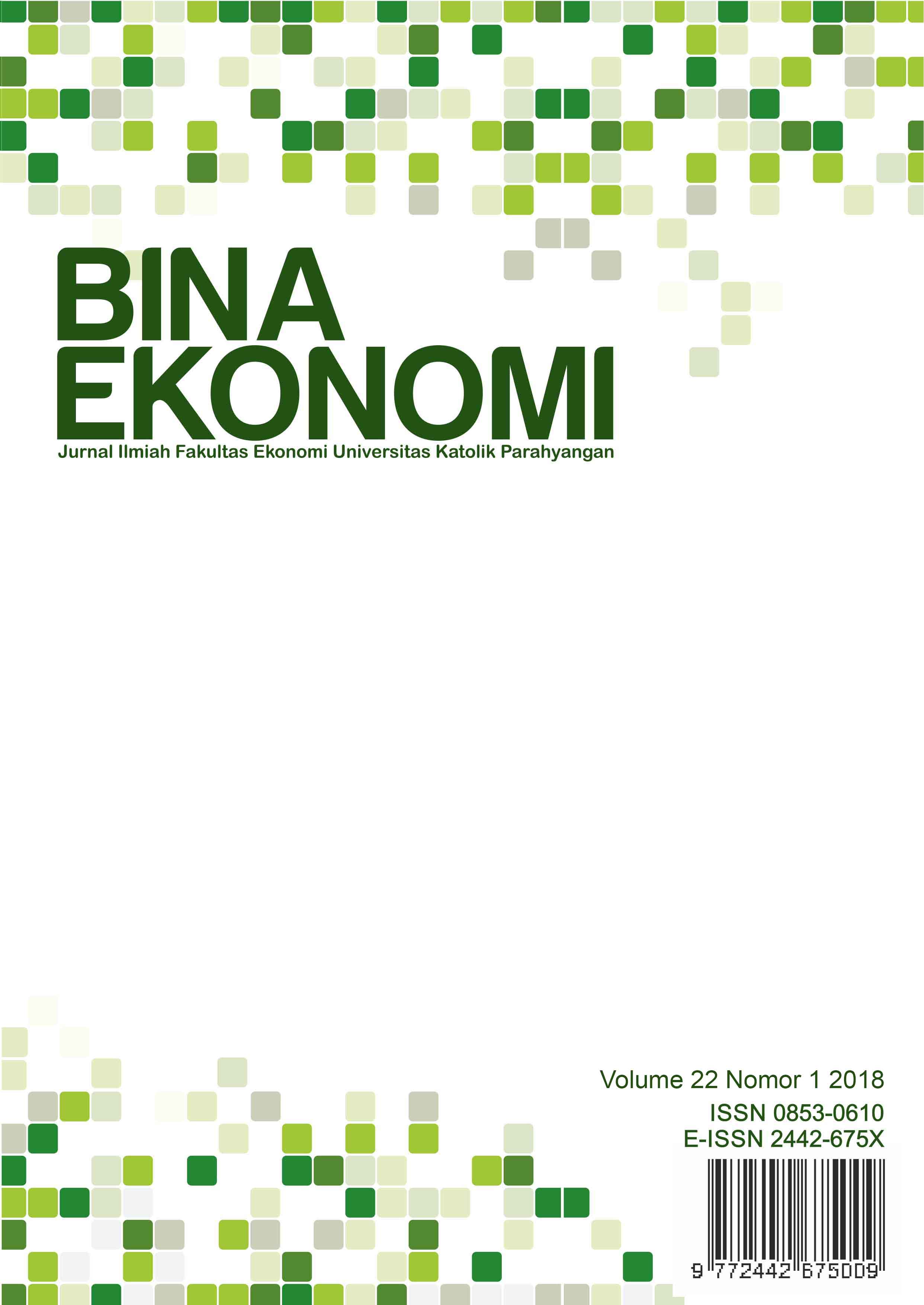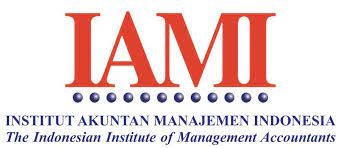PENGARUH E-COMMERCE TERHADAP PERTUMBUHAN EKONOMI INDONESIA
DOI:
https://doi.org/10.26593/be.v22i1.3619.45-64Abstract
The rapid development of information and communication technology has caused the emergence of a new economy, indicated by the phenomenon of internet-based businesses or e-commerce. This research uses the Auto-Regressive Distributed Lag (ARDL) approach to analyzes the impact of e-commerce on Indonesia’s economic growth in 1996-2015. The results show that the development of e-commerce as represented by the increase of the number of e-commerce transaction value, the increase of the number of business websites, and the number of internet users is proven to bring positive impact on Indonesia’s economic growth. This validates the hypothesis which states the increasing number of e-commerce transaction value, which is formed by the interaction between business websites as the supply indicator and the internet users as the demand indicator, shall bring enhancement to the intensity of macroeconomic activities. However, the effect is only significant for the long-run relationship but is not significant in the short-run relationship.
Keywords: e-commerce; economic growth; ARDL
References
A.T. Kearney. (2015). Lifting the barriers to e-commerce in ASEAN. Singapura: CIMB Asean Research Institute.
Al-Tawil, K. M. (n.d). The internet in Saudi Arabia. Dhahran: King Fahd University of Petroleum & Minerals.
Asian Development Bank (ADB). (2015). Asia SME finance monitor 2014. Filipina: Asian Development Bank.
Asosiasi Penyelenggara Jasa Internet Indonesia (APJII). (2016). Infografis penetrasi & perilaku pengguna internet Indonesia survey 2016. Jakarta: APJII.
Association of Southeast Asian Nations (ASEAN). (2015). ASEAN economic community blueprint 2025. Jakarta: ASEAN Secretariat.
Badan Pusat Statistik (BPS). (2016). Produk domestik bruto (lapangan usaha). Diunduh tanggal 26 Maret 2016 dari https://www.bps.go.id/Subjek/view/id/11#subjekViewTab3|accordion-daftar-subjek2
Badan Pusat Statistik (BPS). (2017). Pengertian pendapatan nasional. Diunduh tanggal 13 Maret 2017 dari https://www.bps.go.id/subjek/view/id/11
China Education and Research Network (CERNET). (2013). Evolution of internet in China. Diunduh tanggal 21 Maret 2017 dari http://www.edu.cn/introduction_1378/20060323/t20060323_4285.shtml
DemenBelanja.com. (2016). Pusat informasi toko online. Diunduh tanggal 26 Maret 2016 dari http://demenbelanja.com/
Economides, N. (1996). The economics of networks. International Journal of Industrial Organization, 14(2), 1-36.
Elseoud, M. S. A. (2014). Electronic commerce and economic growth in Saudi Arabia. International Journal of Economics, Commerce and Management, 2(5), 1-16.
Firdaus, M. (2007). Posisi Indonesia dalam era peradaban informasi. Jurnal Administrasi Negara, 13(2).
Freund, C. L., & Weinhold, D. (2004). The effect of the internet on international trade. Journal of International Economics, 62(1), 171-189. doi:10.1016/S0022-1996(03)00059-X
Georgiou, M. N. (2009). E-commerce has a positive impact on economic growth: A panel data analysis for Western Europe. Diunduh tanggal 25 Januari 2016 dari http://ssrn.com/abstract=1484687
Gujarati. (2004). Basic econometrics. The McGraw-Hill Companies, 4th edition.
Indonesian E-commerce Association (idEA). (2016). Direktori keanggotaan. Diunduh tanggal 26 Maret 2016 dari https://www.idea.or.id/direktori-member
Jahangard, E., & Pourahmadi, Z. (2013). The effects of broadband infrastructure on economic growth in developing countries. Iranian Journal of Economic Studies, 2(2), 1-23.
Kelly, K. (1998). New rules for the new economy. New York: Penguin.
Kementerian Koordinator Bidang Perekonomian Republik Indonesia (Kemenko Bidang Perekonomian RI). (2016). Paket kebijakan ekonomi tahap XIV roadmap e-commerce. Jakarta: Kementerian Koordinator Bidang Perekonomian Republik Indonesia.
Khalidi, F. (2015). BMI prediksi belanja online tumbuh 57% tahun 2015. Diunduh tanggal 21 Maret 2017 dari http://swa.co.id/swa/trends/business-research/bmi-research-pasar-belanja-online-di-tahun-2015-semakin-menarik
Liu, S. (2013). An empirical study on e-commerce’s effect on economic growth. International Conference on Education Technology and Management Science (ICETMS 2013), 81-84. doi:10.2991/icetms.2013.260
Marwadi, M. C. (2014). Error correction mechanism (ECM). Diunduh tanggal 5 Maret 2016 dari http://statistikceria.blogspot.co.id/2014/02/error-correction-mechanism-ecm.html?m=1
Pradana, M. (2015). Klasifikasi jenis-jenis bisnis e-commerce di Indonesia. Jurnal Neo-bis, 9(2), 32-40.
Prijambodo, B. (1995). Teori pertumbuhan endogen: tinjauan teoritis singkat dan implikasi kebijaksanaannya. Perencanaan Pembangunan, 3, 64-82.
Qu, L., & Chen, Y. (2014). The impact of e-commerce on China’s economic growth. WHICEB 2014 Proceedings. Paper 101. Diunduh dari http://aisel.aisnet.org/whiceb2014/101
Solow, R. M. (1956). A contribution to the theory of economic growth. The Quarterly Journal of Economics, 70(1), 65-94.
Stiawan, D. (2002). E-commerce. Diunduh tanggal 13 Desember 2016 dari http://deris.unsri.ac.id/materi/deris/ecommerce_deris.pdf
Symantec. (2015). Internet security threat report appendices. California: Symantec Corporation.
Teguh, E., et al. (2015). The dawn of an e-commerce age. Indonesia: CIMB.
Todaro, M. P. (1999). Economic development. Addison Wesley Longman, 7th edition.
Wang, Y. (2016). What are the biggest obtacles to growth of SMEs in developing countries? –A picture emerging from an enterprises survey. Praha: Charles University.
World Bank. (2016). GDP growth (annual %). Diunduh tanggal 12 Juli 2016 dari http://data.worldbank.org/indicator/NY.GDP.MKTP.KD.ZG?locations=ID
World Bank. (2016). Inflation, consumer prices (annual %). Diunduh tanggal 12 Juli 2016 dari http://data.worldbank.org/indicator/FP.CPI.TOTL.ZG
World Bank. (2016). Internet users. Diunduh tanggal 6 Januari 2016 dari http://data.worldbank.org/indicator/IT.NET.USER.P2
World Bank. (2016). Population, total. Diunduh tanggal 30 Desember 2016 dari http://data.worldbank.org/indicator/SP.POP.TOTLL













